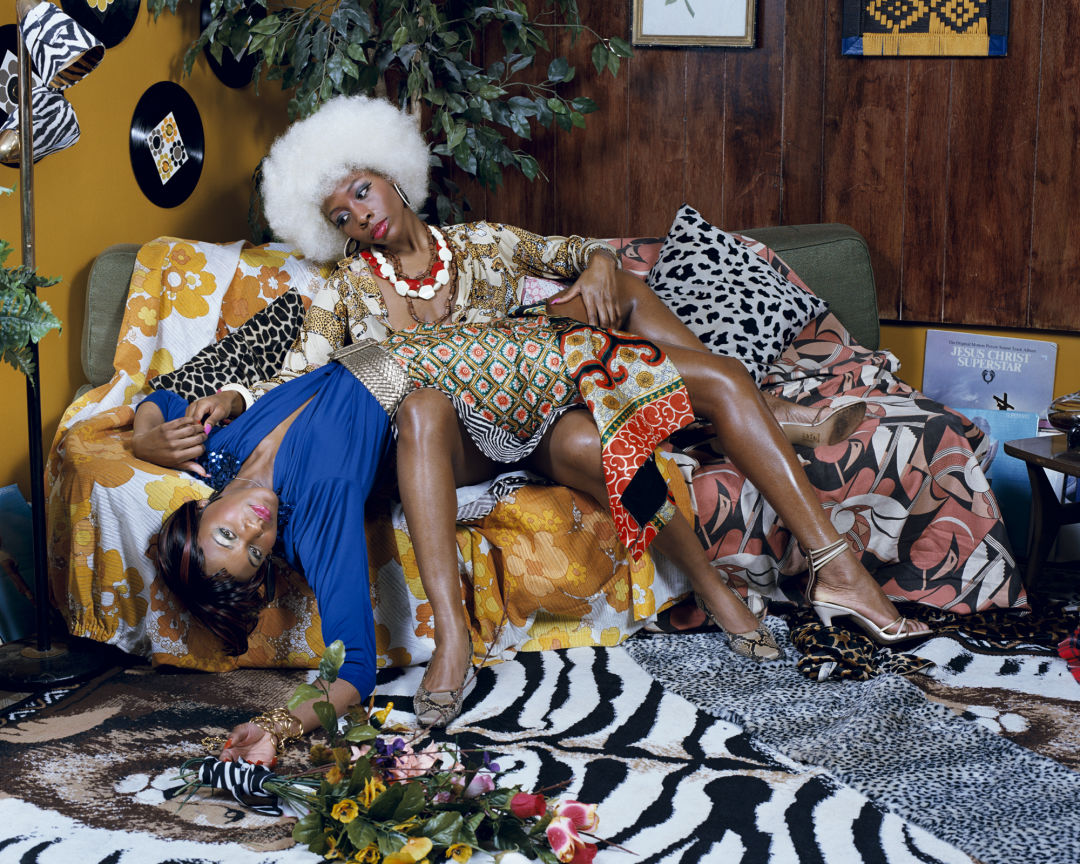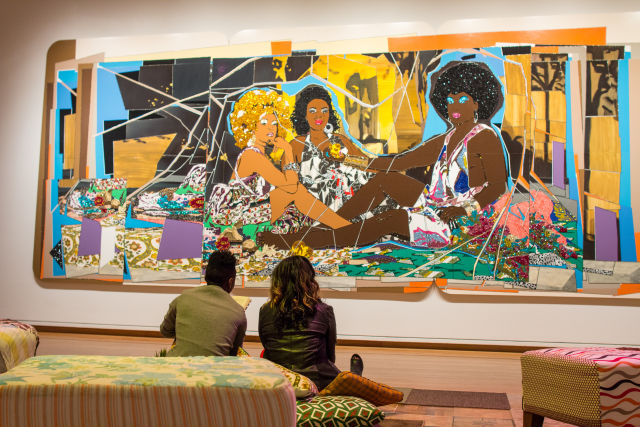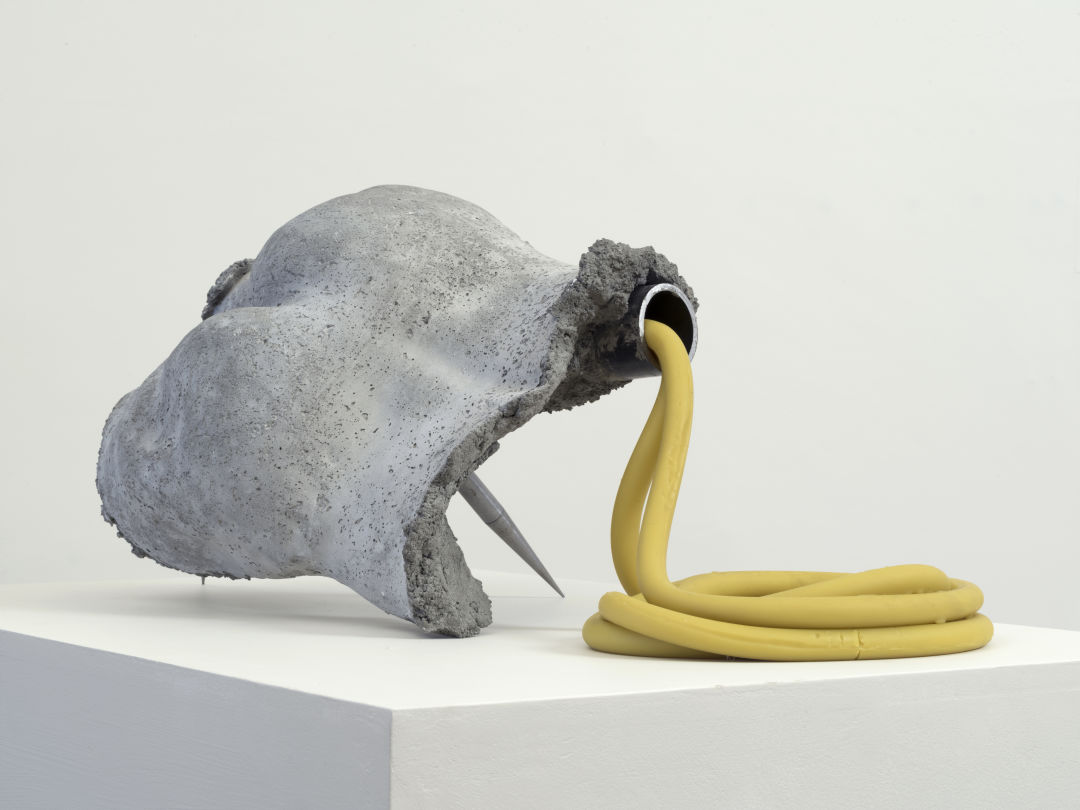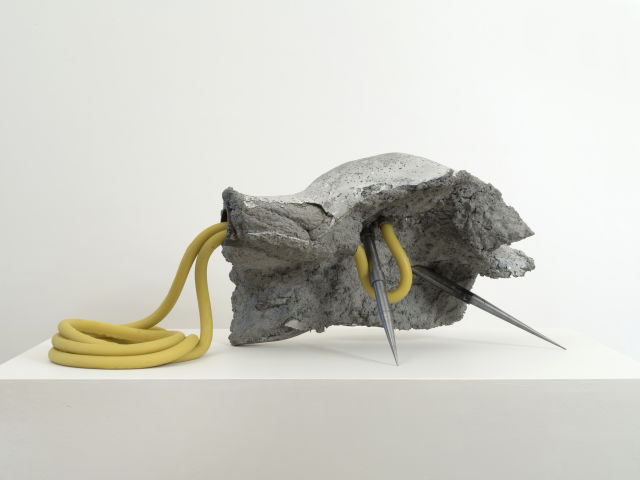Mickalene Thomas’s and Martha Friedman’s Exhibits at Henry Art Gallery Explore Bodies

La leçon d’amour by Mickalene Thomas.
Image: Courtesy Henry Art Gallery
Perhaps you saw Mickalene Thomas’s Le déjeuner sur l’herbe: Les trois femme noires in Figuring History earlier this year at SAM. In the painting, Thomas renders in fractured collagist splendor—rhinestone, acrylic, enamel, wood panel—three black women sitting together. It quotes, and reimagines, Manet's Le déjeuner sur l’herbe (which shows two clothed men and a nude woman, all white, luncheoning on grass). But Thomas’s painting also reimagines her own photograph of the same name, currently on display at Henry Art Gallery.

Le dejeuner sur l’herbe: Les Trois Femme Noires on display at SAM.
Image: Courtesy Seattle Art Museum
Enter Muse: Mickalene Thomas Photographs and Tête-à-Tête—a show of the painter’s photography and video art—and if you’re conversant with Thomas’s painting, you’ll likely have this experience repeatedly. Din Une Tres Belle Negresse #1—another acrylic and rhinestone work—reappeared as a photograph of the same name.
The exhibit itself turns these types of repetitions and quotations into a vortex of image and intimacy. It invites you both into Thomas’s process and into her way of seeing the world in general, and black women in particular. A recreation of her studio, which works as background in many photos, sits near the exhibits entrance. Two film instillations run in opposite rooms; Thomas's Je T'aime is a dual screen meditation on looking at women. Interspersed among Thomas’s photos are those by artists who inspired her work (the “tête-à-tête”): Derrick Adams, Carrie Mae Weems, LaToya Ruby Frazier, and others.
When, for example, you come across a pair of photos by Deana Lawson alongside Thomas’s photos, the friction is immediate and ecstatic. Both photographers capture black women in posed images. From across the room you might even mistake one of Lawson’s prints for another by Thomas. But as you approach the similarities both fade and deepen. Lawson’s subject poses on a patterned bed spread but the wall behind her remains nearly bare, save a single picture hung high. Both photographers see triumph in their subjects, but the approaches diverge: If Lawson is a documentarian, Thomas is a studio filmmaker. In Thomas's photos both subjects and environments very nearly glow, a sort of photographic repetition of the rhinestones she uses in paintings.
These repetitions and iterations are what the show hinges on: how Thomas sees, as photographer, as filmmaker, as viewer, as black woman. By ushering you into her process, her patterns of vision and creation, the show also becomes about how you see each of these layers.

A sculpted butt from Castoffs.
Image: Courtesy Henry Art Gallery
Downstairs at henry art gallery you'll find a very different look at the female gaze. A male body is broken apart. From its cragged surfaces snake rubber tubes like industrial intestines. Long metal spikes threateningly sprout. As you pass between the sculptures on pedestals (32 in total) each reveals itself, often only from one side, to be another bit of sculpted body: an ankle, a hand grabbing a penis, a shoulder, a hip.
Martha Friedman’s Castoffs opened in June and remains on display through February. The exhibit hinges on a word: concrete. The sculptures themselves are concrete. But concrete also is the idea that Friedman interrogates. Here the human body, that of choreographer and dancer Silas Reiner, is not singular, not discrete. The platonic male form is pulled apart, multiplied, abstracted, industrialized.

Another view of a sculpture from Castoffs.
Image: Courtesy Henry Art Gallery
Much like Thomas’s photos, Castoffs is classically informed. The forms and ideals of sculpture—David or Farnese Hercules—are disrupted, so violently that it verges on dark comedy. A muscled male butt appears here, much as in classical sculpture, but circle the sculpture and it immediately gives way to metal spikes, rubber tube threaded through. You may laugh, you may shiver. Your skin may goosepimple. What Friedman's grid of sculptures suggests—about gender and body image and industrial invasion—ties elegantly to its first impact: the visceral.
This post was updated on August 8 and 9 to correct typos: Deana Lawson, not Dean Lawson; and Castoffs, not Castaways.




